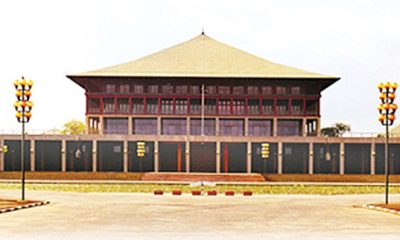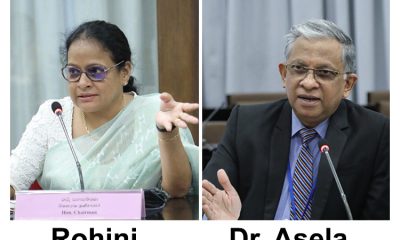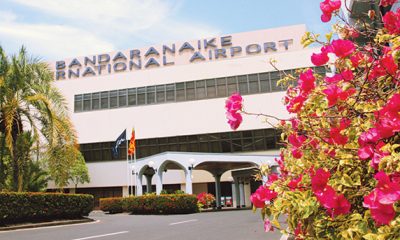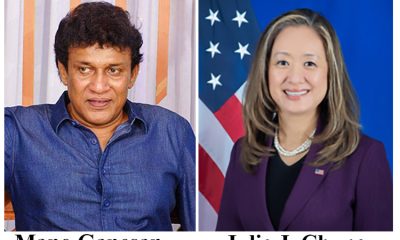Features
The Colombo Plan and entertaining on the Government account

SWRD stands the whiskies after his ‘saruwath’ party
(Excerpted from Memoirs of a Cabinet Secretary by BP Peiris)
I must refer here to what has come to be known as the Colombo Plan, of which much has been written. The matter was first raised by Mr J. R. Jayewardene who asked the Conference to consider the following resolution:
“To ensure a high and stable level of employment and to raise the standard of living of underdeveloped countries in South-East Asia, whether within the Commonwealth or outside it, it is necessary to develop their agricultural and industrial economies. This Conference, therefore, agrees to appoint a committee of officials of the countries concerned to obtain information and to prepare a 10-year plan for the development of these countries.
“The other members of the Commonwealth should consider means of providing such assistance as may be necessary for the implementation of this plan with money, guaranteed prices, technical skill and machinery. The plan should be examined by a committee of experts who, after visiting the countries concerned, should make recommendations with regard to the help which the Commonwealth countries can give in carrying out this programme.”
At a later meeting, Mr Spender informed the Conference that when the Australian Delegation had compared their paper with Mr Jayewardene ‘s resolution, they thought that the recommendations in both could be combined into a single whole and the two Delegations had produced, in consultation with the New Zealand Delegation, a fresh resolution. This is the resolution which put the Colombo Plan on its feet. On this plan, this country has received tremendous aid from several Commonwealth. countries, particularly Canada, Australia, New Zealand and the United Kingdom. Our officials have, with their natural lethargy, delayed or failed to take full advantage of this assistance.
On January 14, 1950, at the public sitting, the final one, which was held in the Senate Chamber (after a heated hoo-ha between me and Samarawickrama, Clerk to the Senate, “Where on earth have you heard of a Legislative Chamber being used for a public sitting like this? etc. etc.”) all the Heads of Delegations spoke.
Mr D.S. Senanayake thanked the delegates who had come to the Conference at great inconvenience to themselves. The final communique was read. The Rt Hon. Philip Noel Baker then moved that an additional paragraph as follows be added at the end of the Communique:
“At the conclusion of the final meeting of Ministers this morning, the representatives of all the other Commonwealth Governments expressed their appreciation of the helpful manner in which Mr Senanayake had presided over their meetings, and their gratitude for the generous hospitality accorded to them by the Government of Ceylon during their stay in the Island.”
He said: “Mr. Prime Minister, It has been said with great eloquence how much we all owe to you, to your Government and to your people. But I think it right that this should also be recorded in history in the communique which we issue this morning… I venture to think that these discussions have been of lasting and dynamic importance to our peoples and to the world, and not the least important of what has happened, if I may say so, has been your speech at the opening Conference and the speeches which have been made this morning. I beg to move, is it agreed, Gentlemen?” Cries of “Aye”.
Every day of the Conference, there was a cocktail party by a Minister for the delegates. This put the Secretariat to a great deal of inconvenience. We could not refuse to attend; we also had to complete our minutes. After a couple of drinks, Sir Norman and his assistants used to take a hurried departure to the office. We had to dress to attend these parties and then take our bow ties and collars off when we got back.
The last party was by Mr S.W.R.D. Bandaranaike, Minister of Local Government and Leader of the House of Representatives, who was not a member of the Ceylon Delegation. He therefore did not know the delegates and the delegates did not know him. His party was at the House of Representatives and he instructed the Police to send the delegates up the main steps facing the sea.
I was instructed by letter to come and assist him with the introductions. I took this as an order and attended in black trousers and a white jacket. S.W.R.D. was in what is known as the National Dress, that is, a cloth, a banian or something looking like a shirt above it and a scarf across his shoulders. I took my place next to him at the head of the steps. The first invitee was climbing up the steps and he asked me who he was. As there was a huge Grecian Pillar which obstructed my view, I took a couple of steps forward and said it was Sir Norman Brook, Secretary to the Cabinet.
Brook came to the top of the steps, recognized me, passed the host, and said “How do you do, Peiris”. I said “This is the Honorable the Minister” and he greeted the Minister with a “How do you do, Sir.” For what reason I did riot know, but mine host appeared to be a bit annoyed with me. The same thing happened with the second guest, Mr Lester Pearson from Canada, who greeted me first and had to be introduced by me to the Minister. S.W.R.D. was now really annoyed with me and snapped “Take two steps back” which I did, and I was again obstructed by the pillar.
“Who’s that?” he asked, as the third guest was climbing up and I said it was Doidge from New Zealand. To do this, I had to take two steps forward, look, and, in accordance with orders, take two steps back. “How do you do”, gleamed the Minister, and he was happy. After that, it worked with almost military precision with the host, on the one hand, greeting his guest by their surnames and I, on the other, doing a little goose-stepping by his side.
This was the last party in honour of the delegations. It was also the first and the only party at which no alcoholic drinks were served. Pink and green drinks were going round and Ernest Bevin insisted on a whisky-soda which had to be hurriedly obtained from the Refreshment Room. The party was from 7 to 8. 30 p.m. There is a limit to the number of glasses of hair-oil that a guest can drink, and by 8. p.m, every guest had gone.
It was the dullest party I had attended. I asked Ralph Deraniyagala, Clerk to the House, fora whisky, and while Ralph and I were having our drink in his room, S.W.R.D. came in and Ralph said to him “Solomon, B. P. said this was not his idea of a party and that he wouldn’t have come unless you had ordered him to do so. He wanted whisky, so I’ve ordered it on your account.”
“Quite right,” said S.W.R.D. “Put it on my chit and order another.”
A weekend intervened during the Conference and the delegates were taken on a sight-seeing tour, some to the ruined cities, some to Kandy, and the others to Nuwara Eliya. They traveled in Government cars, each party accompanied by a Government representative. I was asked to look after my colleague Bavin, who did not want to go to any of these places, but desired to sea bathe: l was an owner, driver and asked for a Government car as I was far too tired after the Conference work to drive a long distance.
I was told that no cars, were available and asked to use my own car and charge mileage. Bavin was to be treated as a State Guest and I was to charge all expenses to Government account. As I dislike talking while I am driving, and as I did not like to drive Bavin fifty miles out and back in silence, I asked my friend Alexis Roberts to join us and keep Bavin amused on the trip. Roberts was a great talker, well-informed and well-read. We drove to the Ambalangoda Resthouse where Bavin went twice into the sea, after which, he asked for a gin and I therefore ordered three.
In all, we had nine gins before lunch. I was careful to preserve the bills. On the way back, Bavin wanted to have another dip, and I turned into the Bentota Resthouse, where we had beer. At Panadura, I bought a bottle of whisky. We saw the elephants dance at the zoo. Finally, home to my place for – whisky and music, which my guest seemed to enjoy, provided it was not the pop variety.
Later in the evening, I dropped him back at his hotel. A few days after the departure of the delegates to their home countries, I sent to the Ministry of External Affairs, my claim for expenses incurred in taking Bavin out as a State Guest. Every item of claim was supported by what, in audit, is called a “Voucher”. My claim included traveling in a Peugeot car (weight and horse power specified) to Ambalangoda and back, nine gins, three ginger ales, three lunches, three pints of beer, three teas, one bottle whisky and three zoo tickets.
My claim was queried on two points by my good friend Jayamanne, Officer of Protocol: one, I was asked why a third man was taken and who he was; two, why was so much liquor consumed. On the first point, I replied I had asked for a Government car which had been refused, that as a careful driver, I watch the road when driving and was not in the habit of talking, that if I took a Government guest out, it was not the done thing to bore him, and that I therefore invited a friend of mine to join us and keep our guest entertained with his conversation at which he was very good.
On the second point, I said that Bavin had three gins after his two swims (for which no charge had been made) and that I thought courtesy demanded that we keep in step; similarly with the beer, and that, as he was a guest of the Government, it would have been an insult to him, as well as to the Government, if I had bought only a pint of whisky and then run short. I said I did not know Bavin’s capacity, but his lunchtime performance showed he was a good stayer.
I therefore bought a full bottle, but only quarter of it was consumed. I added that it would have been an unpardonable crime to have thrown the balance down the drain and an utter nuisance and a waste of public officers’ time to fill up innumerable forms to return it to the Government Stores. In the circumstances, I did the only sensible thing by finishing the bottle myself in small daily doses. My claim was paid in full.
Features
The heart-friendly health minister

by Dr Gotabhya Ranasinghe
Senior Consultant Cardiologist
National Hospital Sri Lanka
When we sought a meeting with Hon Dr. Ramesh Pathirana, Minister of Health, he graciously cleared his busy schedule to accommodate us. Renowned for his attentive listening and deep understanding, Minister Pathirana is dedicated to advancing the health sector. His openness and transparency exemplify the qualities of an exemplary politician and minister.
Dr. Palitha Mahipala, the current Health Secretary, demonstrates both commendable enthusiasm and unwavering support. This combination of attributes makes him a highly compatible colleague for the esteemed Minister of Health.
Our discussion centered on a project that has been in the works for the past 30 years, one that no other minister had managed to advance.
Minister Pathirana, however, recognized the project’s significance and its potential to revolutionize care for heart patients.
The project involves the construction of a state-of-the-art facility at the premises of the National Hospital Colombo. The project’s location within the premises of the National Hospital underscores its importance and relevance to the healthcare infrastructure of the nation.
This facility will include a cardiology building and a tertiary care center, equipped with the latest technology to handle and treat all types of heart-related conditions and surgeries.
Securing funding was a major milestone for this initiative. Minister Pathirana successfully obtained approval for a $40 billion loan from the Asian Development Bank. With the funding in place, the foundation stone is scheduled to be laid in September this year, and construction will begin in January 2025.
This project guarantees a consistent and uninterrupted supply of stents and related medications for heart patients. As a result, patients will have timely access to essential medical supplies during their treatment and recovery. By securing these critical resources, the project aims to enhance patient outcomes, minimize treatment delays, and maintain the highest standards of cardiac care.
Upon its fruition, this monumental building will serve as a beacon of hope and healing, symbolizing the unwavering dedication to improving patient outcomes and fostering a healthier society.We anticipate a future marked by significant progress and positive outcomes in Sri Lanka’s cardiovascular treatment landscape within the foreseeable timeframe.
Features
A LOVING TRIBUTE TO JESUIT FR. ALOYSIUS PIERIS ON HIS 90th BIRTHDAY

by Fr. Emmanuel Fernando, OMI
Jesuit Fr. Aloysius Pieris (affectionately called Fr. Aloy) celebrated his 90th birthday on April 9, 2024 and I, as the editor of our Oblate Journal, THE MISSIONARY OBLATE had gone to press by that time. Immediately I decided to publish an article, appreciating the untiring selfless services he continues to offer for inter-Faith dialogue, the renewal of the Catholic Church, his concern for the poor and the suffering Sri Lankan masses and to me, the present writer.
It was in 1988, when I was appointed Director of the Oblate Scholastics at Ampitiya by the then Oblate Provincial Fr. Anselm Silva, that I came to know Fr. Aloy more closely. Knowing well his expertise in matters spiritual, theological, Indological and pastoral, and with the collaborative spirit of my companion-formators, our Oblate Scholastics were sent to Tulana, the Research and Encounter Centre, Kelaniya, of which he is the Founder-Director, for ‘exposure-programmes’ on matters spiritual, biblical, theological and pastoral. Some of these dimensions according to my view and that of my companion-formators, were not available at the National Seminary, Ampitiya.
Ever since that time, our Oblate formators/ accompaniers at the Oblate Scholasticate, Ampitiya , have continued to send our Oblate Scholastics to Tulana Centre for deepening their insights and convictions regarding matters needed to serve the people in today’s context. Fr. Aloy also had tried very enthusiastically with the Oblate team headed by Frs. Oswald Firth and Clement Waidyasekara to begin a Theologate, directed by the Religious Congregations in Sri Lanka, for the contextual formation/ accompaniment of their members. It should very well be a desired goal of the Leaders / Provincials of the Religious Congregations.
Besides being a formator/accompanier at the Oblate Scholasticate, I was entrusted also with the task of editing and publishing our Oblate journal, ‘The Missionary Oblate’. To maintain the quality of the journal I continue to depend on Fr. Aloy for his thought-provoking and stimulating articles on Biblical Spirituality, Biblical Theology and Ecclesiology. I am very grateful to him for his generous assistance. Of late, his writings on renewal of the Church, initiated by Pope St. John XX111 and continued by Pope Francis through the Synodal path, published in our Oblate journal, enable our readers to focus their attention also on the needed renewal in the Catholic Church in Sri Lanka. Fr. Aloy appreciated very much the Synodal path adopted by the Jesuit Pope Francis for the renewal of the Church, rooted very much on prayerful discernment. In my Religious and presbyteral life, Fr.Aloy continues to be my spiritual animator / guide and ongoing formator / acccompanier.
Fr. Aloysius Pieris, BA Hons (Lond), LPh (SHC, India), STL (PFT, Naples), PhD (SLU/VC), ThD (Tilburg), D.Ltt (KU), has been one of the eminent Asian theologians well recognized internationally and one who has lectured and held visiting chairs in many universities both in the West and in the East. Many members of Religious Congregations from Asian countries have benefited from his lectures and guidance in the East Asian Pastoral Institute (EAPI) in Manila, Philippines. He had been a Theologian consulted by the Federation of Asian Bishops’ Conferences for many years. During his professorship at the Gregorian University in Rome, he was called to be a member of a special group of advisers on other religions consulted by Pope Paul VI.
Fr. Aloy is the author of more than 30 books and well over 500 Research Papers. Some of his books and articles have been translated and published in several countries. Among those books, one can find the following: 1) The Genesis of an Asian Theology of Liberation (An Autobiographical Excursus on the Art of Theologising in Asia, 2) An Asian Theology of Liberation, 3) Providential Timeliness of Vatican 11 (a long-overdue halt to a scandalous millennium, 4) Give Vatican 11 a chance, 5) Leadership in the Church, 6) Relishing our faith in working for justice (Themes for study and discussion), 7) A Message meant mainly, not exclusively for Jesuits (Background information necessary for helping Francis renew the Church), 8) Lent in Lanka (Reflections and Resolutions, 9) Love meets wisdom (A Christian Experience of Buddhism, 10) Fire and Water 11) God’s Reign for God’s poor, 12) Our Unhiddden Agenda (How we Jesuits work, pray and form our men). He is also the Editor of two journals, Vagdevi, Journal of Religious Reflection and Dialogue, New Series.
Fr. Aloy has a BA in Pali and Sanskrit from the University of London and a Ph.D in Buddhist Philosophy from the University of Sri Lankan, Vidyodaya Campus. On Nov. 23, 2019, he was awarded the prestigious honorary Doctorate of Literature (D.Litt) by the Chancellor of the University of Kelaniya, the Most Venerable Welamitiyawe Dharmakirthi Sri Kusala Dhamma Thera.
Fr. Aloy continues to be a promoter of Gospel values and virtues. Justice as a constitutive dimension of love and social concern for the downtrodden masses are very much noted in his life and work. He had very much appreciated the commitment of the late Fr. Joseph (Joe) Fernando, the National Director of the Social and Economic Centre (SEDEC) for the poor.
In Sri Lanka, a few religious Congregations – the Good Shepherd Sisters, the Christian Brothers, the Marist Brothers and the Oblates – have invited him to animate their members especially during their Provincial Congresses, Chapters and International Conferences. The mainline Christian Churches also have sought his advice and followed his seminars. I, for one, regret very much, that the Sri Lankan authorities of the Catholic Church –today’s Hierarchy—- have not sought Fr.
Aloy’s expertise for the renewal of the Catholic Church in Sri Lanka and thus have not benefited from the immense store of wisdom and insight that he can offer to our local Church while the Sri Lankan bishops who governed the Catholic church in the immediate aftermath of the Second Vatican Council (Edmund Fernando OMI, Anthony de Saram, Leo Nanayakkara OSB, Frank Marcus Fernando, Paul Perera,) visited him and consulted him on many matters. Among the Tamil Bishops, Bishop Rayappu Joseph was keeping close contact with him and Bishop J. Deogupillai hosted him and his team visiting him after the horrible Black July massacre of Tamils.
Features
A fairy tale, success or debacle

Sri Lanka-Singapore Free Trade Agreement
By Gomi Senadhira
senadhiragomi@gmail.com
“You might tell fairy tales, but the progress of a country cannot be achieved through such narratives. A country cannot be developed by making false promises. The country moved backward because of the electoral promises made by political parties throughout time. We have witnessed that the ultimate result of this is the country becoming bankrupt. Unfortunately, many segments of the population have not come to realize this yet.” – President Ranil Wickremesinghe, 2024 Budget speech
Any Sri Lankan would agree with the above words of President Wickremesinghe on the false promises our politicians and officials make and the fairy tales they narrate which bankrupted this country. So, to understand this, let’s look at one such fairy tale with lots of false promises; Ranil Wickremesinghe’s greatest achievement in the area of international trade and investment promotion during the Yahapalana period, Sri Lanka-Singapore Free Trade Agreement (SLSFTA).
It is appropriate and timely to do it now as Finance Minister Wickremesinghe has just presented to parliament a bill on the National Policy on Economic Transformation which includes the establishment of an Office for International Trade and the Sri Lanka Institute of Economics and International Trade.
Was SLSFTA a “Cleverly negotiated Free Trade Agreement” as stated by the (former) Minister of Development Strategies and International Trade Malik Samarawickrama during the Parliamentary Debate on the SLSFTA in July 2018, or a colossal blunder covered up with lies, false promises, and fairy tales? After SLSFTA was signed there were a number of fairy tales published on this agreement by the Ministry of Development Strategies and International, Institute of Policy Studies, and others.
However, for this article, I would like to limit my comments to the speech by Minister Samarawickrama during the Parliamentary Debate, and the two most important areas in the agreement which were covered up with lies, fairy tales, and false promises, namely: revenue loss for Sri Lanka and Investment from Singapore. On the other important area, “Waste products dumping” I do not want to comment here as I have written extensively on the issue.
1. The revenue loss
During the Parliamentary Debate in July 2018, Minister Samarawickrama stated “…. let me reiterate that this FTA with Singapore has been very cleverly negotiated by us…. The liberalisation programme under this FTA has been carefully designed to have the least impact on domestic industry and revenue collection. We have included all revenue sensitive items in the negative list of items which will not be subject to removal of tariff. Therefore, 97.8% revenue from Customs duty is protected. Our tariff liberalisation will take place over a period of 12-15 years! In fact, the revenue earned through tariffs on goods imported from Singapore last year was Rs. 35 billion.
The revenue loss for over the next 15 years due to the FTA is only Rs. 733 million– which when annualised, on average, is just Rs. 51 million. That is just 0.14% per year! So anyone who claims the Singapore FTA causes revenue loss to the Government cannot do basic arithmetic! Mr. Speaker, in conclusion, I call on my fellow members of this House – don’t mislead the public with baseless criticism that is not grounded in facts. Don’t look at petty politics and use these issues for your own political survival.”
I was surprised to read the minister’s speech because an article published in January 2018 in “The Straits Times“, based on information released by the Singaporean Negotiators stated, “…. With the FTA, tariff savings for Singapore exports are estimated to hit $10 million annually“.
As the annual tariff savings (that is the revenue loss for Sri Lanka) calculated by the Singaporean Negotiators, Singaporean $ 10 million (Sri Lankan rupees 1,200 million in 2018) was way above the rupees’ 733 million revenue loss for 15 years estimated by the Sri Lankan negotiators, it was clear to any observer that one of the parties to the agreement had not done the basic arithmetic!
Six years later, according to a report published by “The Morning” newspaper, speaking at the Committee on Public Finance (COPF) on 7th May 2024, Mr Samarawickrama’s chief trade negotiator K.J. Weerasinghehad had admitted “…. that forecasted revenue loss for the Government of Sri Lanka through the Singapore FTA is Rs. 450 million in 2023 and Rs. 1.3 billion in 2024.”
If these numbers are correct, as tariff liberalisation under the SLSFTA has just started, we will pass Rs 2 billion very soon. Then, the question is how Sri Lanka’s trade negotiators made such a colossal blunder. Didn’t they do their basic arithmetic? If they didn’t know how to do basic arithmetic they should have at least done their basic readings. For example, the headline of the article published in The Straits Times in January 2018 was “Singapore, Sri Lanka sign FTA, annual savings of $10m expected”.
Anyway, as Sri Lanka’s chief negotiator reiterated at the COPF meeting that “…. since 99% of the tariffs in Singapore have zero rates of duty, Sri Lanka has agreed on 80% tariff liberalisation over a period of 15 years while expecting Singapore investments to address the imbalance in trade,” let’s turn towards investment.
Investment from Singapore
In July 2018, speaking during the Parliamentary Debate on the FTA this is what Minister Malik Samarawickrama stated on investment from Singapore, “Already, thanks to this FTA, in just the past two-and-a-half months since the agreement came into effect we have received a proposal from Singapore for investment amounting to $ 14.8 billion in an oil refinery for export of petroleum products. In addition, we have proposals for a steel manufacturing plant for exports ($ 1 billion investment), flour milling plant ($ 50 million), sugar refinery ($ 200 million). This adds up to more than $ 16.05 billion in the pipeline on these projects alone.
And all of these projects will create thousands of more jobs for our people. In principle approval has already been granted by the BOI and the investors are awaiting the release of land the environmental approvals to commence the project.
I request the Opposition and those with vested interests to change their narrow-minded thinking and join us to develop our country. We must always look at what is best for the whole community, not just the few who may oppose. We owe it to our people to courageously take decisions that will change their lives for the better.”
According to the media report I quoted earlier, speaking at the Committee on Public Finance (COPF) Chief Negotiator Weerasinghe has admitted that Sri Lanka was not happy with overall Singapore investments that have come in the past few years in return for the trade liberalisation under the Singapore-Sri Lanka Free Trade Agreement. He has added that between 2021 and 2023 the total investment from Singapore had been around $162 million!
What happened to those projects worth $16 billion negotiated, thanks to the SLSFTA, in just the two-and-a-half months after the agreement came into effect and approved by the BOI? I do not know about the steel manufacturing plant for exports ($ 1 billion investment), flour milling plant ($ 50 million) and sugar refinery ($ 200 million).
However, story of the multibillion-dollar investment in the Petroleum Refinery unfolded in a manner that would qualify it as the best fairy tale with false promises presented by our politicians and the officials, prior to 2019 elections.
Though many Sri Lankans got to know, through the media which repeatedly highlighted a plethora of issues surrounding the project and the questionable credentials of the Singaporean investor, the construction work on the Mirrijiwela Oil Refinery along with the cement factory began on the24th of March 2019 with a bang and Minister Ranil Wickremesinghe and his ministers along with the foreign and local dignitaries laid the foundation stones.
That was few months before the 2019 Presidential elections. Inaugurating the construction work Prime Minister Ranil Wickremesinghe said the projects will create thousands of job opportunities in the area and surrounding districts.
The oil refinery, which was to be built over 200 acres of land, with the capacity to refine 200,000 barrels of crude oil per day, was to generate US$7 billion of exports and create 1,500 direct and 3,000 indirect jobs. The construction of the refinery was to be completed in 44 months. Four years later, in August 2023 the Cabinet of Ministers approved the proposal presented by President Ranil Wickremesinghe to cancel the agreement with the investors of the refinery as the project has not been implemented! Can they explain to the country how much money was wasted to produce that fairy tale?
It is obvious that the President, ministers, and officials had made huge blunders and had deliberately misled the public and the parliament on the revenue loss and potential investment from SLSFTA with fairy tales and false promises.
As the president himself said, a country cannot be developed by making false promises or with fairy tales and these false promises and fairy tales had bankrupted the country. “Unfortunately, many segments of the population have not come to realize this yet”.
(The writer, a specialist and an activist on trade and development issues . )
























